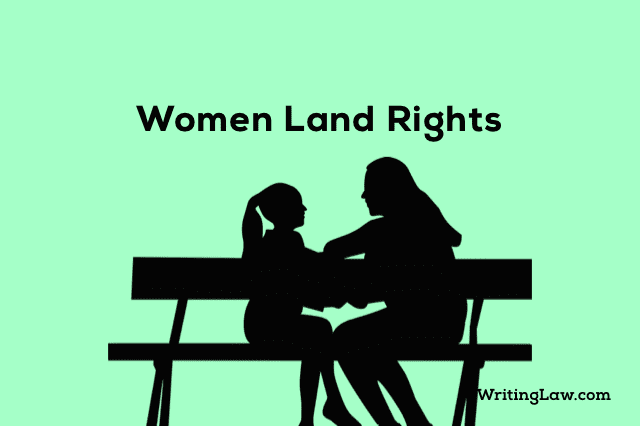
Rural women are among the most disadvantaged group in the developing world.
Gender-based discrimination is prevalent in laws, customs, and practices, resulting in severe inequalities in their ability to access and control land and other natural resources. It also limits their participation in land governance and decision-making, from the household to local and national institutions.
Gender justice in land governance and women’s land rights are critical pillars in promoting and protecting women’s human rights in rural communities. They are not only human rights but are also tied to women’s legal competence, inheritance and property rights, family law, marriage, and involvement in public life.
This law note tells you about the land rights of women and the reason behind the lack of women’s land rights in detail.
Synthesis of Contributions on Land Rights of Women
Now, let us look at the contributing factors in women’s land rights:
1. Facts and Figures on Gender Inequalities in Access to Land
Women are constantly less likely to own or operate land. They are less likely to have access to rented property. Even the land they have access to is generally of lower quality and in smaller plots.
Women who own property do not always have control over what they produce or the resources they grow. Women also face discrimination in inheritance rights. They are less likely to get property through markets and redistributive reforms than males due to discrimination in land markets, disparities in income and credit, and societal discrimination.
2. Laws Are the First Important Step, but They Are Not Enough
State parties are required by the Convention on the Elimination of All Forms of Discrimination Against Women (CEDAW) to pursue both de jure and de facto equality.
Contributors express worry over legal discrimination and, more importantly, the lack of implementation of progressive statutory laws that currently exist, particularly in rural and remote places and among minority and indigenous populations.
To address these issues, the government should go beyond amending legislative frameworks and take steps to promote social change through positive discrimination, such as allocating resources and developing policies that promote and protect women’s land rights and gender equity in land governance.
3. Laws and Policies Should Capture Diversity Among Rural Women and the Ways They Use Land and Natural Resources
Rural women are not a homogeneous population, and inequalities in class, age, and marital status, as well as living with HIV/AIDS or being internally displaced, all have a significant impact on access to land.
Some rural women are also human rights defenders, peacefully advocating for land and environmental rights in their communities. All rural women should be able to choose their land relationship based on their needs and aspirations.
4. States Parties Must Promote Rural Women’s Participation in Land Governance as Full Citizens
Aside from property rights, possessing a land title usually requires having a physical address, which allows access to birth certificates, identity cards, and voting credentials, all of which are necessary to exercise civil and political rights.
Rural women should have the ability to engage meaningfully in land governance and territorial development decisions.
At all levels, from households and communities to land administration organisations and ministries, decisions about how land is utilised, managed, or owned should include women as equal participants in decision-making with males.
5. The Current Status of Land Rights: Laws, Policies, and Regulations
In many countries, statutory law, rules, and regulations, particularly those relating to women’s position, legal ability, inheritance and property rights, family life, and equality within marriage, remain gender-blind and occasionally discriminatory.
Rural women’s human rights, particularly their ability to access, own, acquire, control, administrate, or otherwise use land, are harmed by-laws governing marriage, divorce, widowhood, inheritance, and family ties.
State parties with reservations on Articles 2, 15, and 16 of CEDAW, as well as those who do not recognise women’s rights to make decisions for themselves, inherit, own, and manage a property, and access justice, have raised serious concerns.
“Within the family, women’s lack of legal ability makes them dependent on males and subject to male authority, with limited negotiating power and no resource outside the family.” Source.
While customary institutions play an important role in land governance, discriminatory customs have been raised, particularly in circumstances of legal pluralism where the state legally recognises customary or religious law, but CEDAW compliance is not guaranteed.
It is critical to put together the statutory, customary, and religious legislation, particularly concerning family law and property rights, with the requirements of the Convention, confirming CEDAW’s priority and removing practices that are founded on the belief that women are inferior (Article 5).
Reasons for Women’s Lack of Land Rights
Persisting patriarchy as represented in stereotypes, attitudes, perceptions, and conventions, which causes legal, political, and economic barriers to women’s growth, is the primary cause of discrimination against women in access to land and other natural resources.
Patriarchy and gender stereotypes exist at all levels, from the family to the local community, from administration to broader governance, and from state institutions to civil society and rural organisations.
Rural women are frequently constrained to traditional gender roles of food production and child-rearing, and they accept discriminatory norms and attitudes due to their education and social constraints.
The amount to which women can exercise their land rights is influenced by how they are treated in the home, family, and community.
In addition to statutory and customary discrimination, local leaders in rural and isolated areas frequently govern access to land, in reality, reproducing and reinforcing gender inequality.
States should be proactive in enacting laws and regulations to end gender discrimination and strive to change or abolish discriminatory “customs and practices” (Article 2 of CEDAW).
Women in rural areas lack the authority to assert and defend their land rights. They are usually unaware of their rights because women have less access to education and thus often have low functional literacy. They lack the skills, documents, and chances to engage in land governance, all of which repeat and maintain gender inequities in land access.
Women’s organisations lack the capacity and resources to influence and participate in land governance meaningfully.
Promoting and Protecting Rural Women’s Land Rights
Promoting and protecting the land rights of rural women is essential. Therefore, certain rights are given to women in this regard.
Guaranteeing Rights
There is a need to reform discriminatory, gender-blind laws and policies, including customary laws, in countries where such laws and policies still exist to ensure women’s land rights and full compliance with CEDAW. Even if favourable legal rules and regulations exist, implementation is not proper.
Understanding Rights
It is critical to raise women’s awareness of their rights to inherit the land, own land, and participate in land governance through awareness campaigns, media work, and land rights education programs or modules and by targeting traditional authorities and involving men in general.
Campaigns should be conducted in all relevant languages, including local languages, and formats accessible to all people, including illiterate grassroots women.
Claim Rights
Rural women and their organisations require assistance in the areas of capacity building and resources to document their practices and challenges, gain access to justice systems, monitor compliance with CEDAW and national laws, and most importantly, to mobilise women to advocate for change at all levels.
To achieve improved participation of women, rural women’s organisations require space on national civil society forums addressing land issues.
Conclusion
At a time when global and local competition for land and natural resources has increased land conflicts in many countries, and rural women are disproportionately affected by such conflicts, it is critical to prioritise women and women’s land rights in national development agendas, keeping in mind the three key points that emerged from our consultation:
- the importance of pursuing de facto equality,
- the diversity of rural women and their tenure rights, and
- the importance of women’s engagement in land governance for gender justice.
Read Next:
1. Most Important Legal Rights of Women in India
2. What Are the Rights of a Woman During the Arrest?
3. What Are the Financial Rights of Hindu Woman at the Time of Divorce?
- 13 Characteristics of a Company Under the Companies Act - 5th March 2024
- Lee vs Lee’s Air Farming Ltd – Case Explained - 5th March 2024
- Relevant Facts Under the Indian Evidence Act - 14th January 2024








